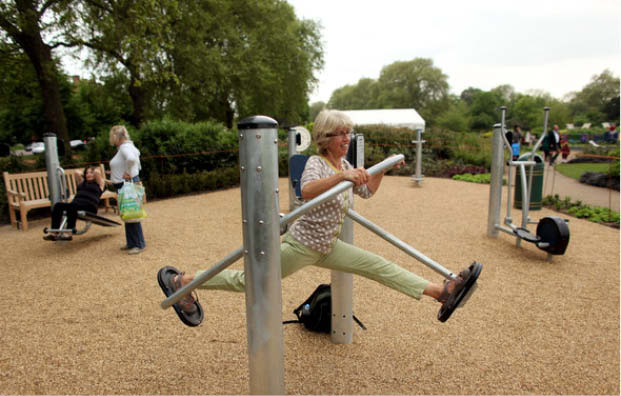Who needs gyms? A new trend in fitness has people who are way past childhood working out – or just hanging out – in playgrounds designed especially for seniors.
And unlike gyms, they’re free.
If you’re thinking swing sets and slides, you’ll either be disappointed or relieved. Most playgrounds for older people feature low-impact exercise equipment designed to promote flexibility, balance and coordination, along with areas that promote community. But just like kids’ playgrounds, they’re meant to be fun.
As George Bernard Shaw famously said, “We don’t stop playing because we grow old; we grow old because we stop playing.”
“If you make it playful, people will enjoy themselves. It won’t feel like a workout, and they’ll want to come back,” says Michael Cohen, the founder of Must Have Play, the first U.S. company dedicated to designing wellness playgrounds for seniors.
Also known as outdoor fitness parks, senior playgrounds started cropping up about two decades ago in China, after a national law came into effect that mandated fitness programs for all ages. The idea spread during the 2000’s to England, Japan, Finland, Japan, Germany, Canada and Spain, where more than 40 percent of the population will be 65-plus by 2050. Barcelona now boasts more than 300 senior playground installations.
Australia definitely has some catching up to do.
What Exactly Is a Senior Playground?
Outdoor senior fitness parks might include elements like stationary and recumbent bicycles, side-by-side striders, face-to-face leg presses and hand-eye dexterity games. You also might find walking paths with ramps, steps and arches; games like bocce, ping pong or horseshoes; and shaded seating areas.
You can get an idea of the variety of equipment by visiting this Pinterest boarddevoted entirely to images of senior playgrounds.
While Asia and Europe have focused on seniors-only playgrounds, some of which are built adjacent to children’s playgrounds to allow grandparents to stay active in the park while their young charges play nearby, the U.S. is moving toward multigenerational playgrounds. For grandparents, it can be a boon, but many seniors would prefer not to have some eight-year-old stare at their attempts to climb the jungle gym. Still, as one blogger put it, “An old bat myself, I find the idea of playing with children much less humiliating (or humbling) than exercising at a gym in the company of impossibly well-toned and hunky 30-year-olds.”
The Benefits of Senior Playgrounds
Whether you’re climbing, pedaling, using the elliptical or walking a trail, the most immediate benefits of senior playgrounds are wellness related. The best installations help to improve balance and minimize the risk of falls, build muscle strength and tone, extend your range of motion, and improve your manual dexterity.
To some extent, these gains have been documented: A 2004 study by Finland’s University of Lapland looked at a group of 40 seniors age 65 to 81 who had access to a senior playground. After three months of regular use,90 minutes a week, the study found improvements in balance, speed and coordination. The seniors were more confident and moved faster, and felt empowered to manage physical obstacles when they met them. What’s more, the seniors in the study said they had fun taking on these challenges in company.
Like any playground, those built for senior or multigenerational use also serve as social hubs. Face-to-face and multi-user equipment makes them great places to meet people and make friends locally, and once you’ve connected, you’re likely to show up tomorrow to meet again.
Add the element of play, and you have the perfect solution for what sometimes ails us as seniors. A well-designed senior or multigenerational playground encourages light-hearted fun. Some things don’t change – playing outside in the open air relieves stress and improves our mood, just as it did when we were kids.
Take a Risk
As we age, we tend to become more fearful for our bodies.
What if I fall?
“If a kid falls, they may get hurt, but they’re probably going to get up,” Cohen says. “If an older adult falls, they might have a fracture. So, who’s going to be there to help them? They take calculated risks in trying something new, preferably because they’ve just seen someone else do it and enjoy themselves.”
We worry about making fools of ourselves, too. In Finland, where senior playgrounds have been a thing for at least ten years, 63-year-old Irmelin Roskila told the BBC that she had started out feeling like “an elephant walking on a narrow beam” but found her agility improved rapidly, so that three months later she could say, “Even in everyday situations when I’m walking around I will now try out playground equipment. It has opened up new possibilities, not just physically.”
By taking risks, we push ourselves outside our physical comfort zones and gradually extend our capabilities. Then we start to feel differently about ourselves.





